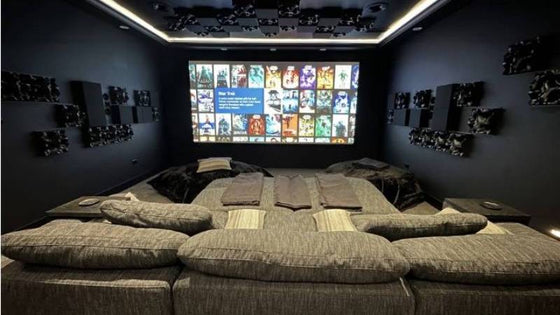Creating a system you love shouldn't be difficult. The Acoustic Frontiers blog is here to help.

Room modes are caused by perfect constructive interference between a sound wave traveling between two boundaries. In rectangular rooms the first axial mode of a room can be found through an application of the wavelength formula as follows:
1st modal frequency = speed of sound / 2 * distance between boundaries
The axial modes contain the most power and therefore typically cause the largest problems. These modes are caused by interference between two parallel surfaces i.e. those related to the length, width and height dimensions of the room. Let's look at an example to help illustrate things: The 1st axial mode for a 20ft long room would be: 1140ft per second / (2 x 20ft) = 28.5Hz. If we examined this room using a high resolution acoustic measurement we would expect to see a peak in the frequency response and ringing in the time domain at the resonance frequency (i.e. 28.5Hz). From a sound quality perspective we would expect to hear lack of smoothness, boomy bass and also an impact on clarity, as low level sounds are obscured by the excessive length of time it takes for bass notes to decay.
There are also tangential and oblique modes, which are less powerful and are formed by interference between four and six boundaries respectively. The final consideration is to realize that more than one pattern of constructive interference can fit between two boundaries. In fact modal resonances can be found at multiples of the 1st modal frequency i.e. 28.5*2 (57ft), 28.5*3 (85.5ft), 28.5*4 (114ft), etc. We won't discuss these added complications further but it is important to be aware of them.
To simplify things we will just consider one example - using subwoofers reduce the impact of the 1st axial length mode. The diagram below shows what we would expect to see if we were to measure how sound pressure level varies by distance between the front and back walls of our 20ft long room.

Looking at the diagram you can see that SPL is a maximum near the walls and at a minimum in the center of the room. The minimum point is called a ‘null’. Each side of the null the lobes of the room mode are in opposite polarity.
The effect of a subwoofer on the level of a room mode depends upon where you put the subwoofer. If you put it in the center of the room at the null there would be no energy coupling between the subwoofer and the mode. The mode would not be excited and there would be no measureable peak in the frequency response or ringing in the time domain.
The other way to achieve the same effect is to use two subwoofers, each of which is positioned in a lobe of different acoustic polarity. This means that the positive sound wave created by the subwoofer in the left, positive lobe is met by a sound wave of equal level but negative polarity created by the subwoofer in the other lobe. If you have two sound waves that are identical in frequency and level but the polarities are opposite then there will be perfect cancellation. This means that there will again not be any measurable frequency response peak or time domain ringing.
There is so much that can be achieved by listening to a system to identify a sound quality issue, using measurements to find the cause and then using appropriate solutions. In this case I hope you can see how subwoofers can be used to effectively solve some room mode related problems.
Learn how early home theater design, layout, and acoustic treatment improve performance in new home construction.
This media room was intentionally designed to feel like part of the home—not a separate, tech-heavy space. Through careful acoustic planning, equipment integration, and final calibration, we achieved a room that is both beautiful to live in and immersive to experience.
"No other subwoofer system I’ve owned even comes close to what this room delivers. Reaching out to Acoustic Frontiers was one of the best decisions I’ve made—I highly recommend working with them if you want to get the most out of your theater."

Nyal Mellor, Founder, Acoustic Frontiers



Nyal Mellor
Author